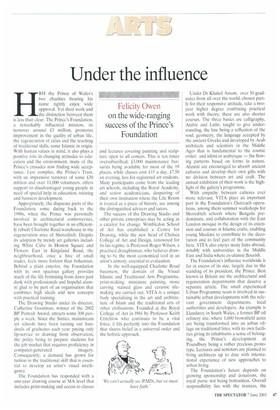Under the influence
Felicity Owen on the wide-ranging success of the Prince's Foundation
HRH the Prince of Wales's two charities bearing his name rightly enjoy wide approval. Yet their work and the distinction between them is less than clear. The Prince's Foundation, a remarkably influential minnow, its turnover around £3 million, promotes improvement in the quality of urban life, the regeneration of cities and the teaching of traditional skills, some Islamic in origin. With human values in mind, it also plays a positive role in changing attitudes to education and the environment, many of the Prince's crusades now finding wide acceptance. Less complex, the Prince's Trust, with an impressive turnover of some £30 million and over 11,000 volunteers, offers support to disadvantaged young people in need of special help in education, training and business development.
Appropriately, the disparate parts of the Foundation, some dating back to the 1980s, when the Prince was personally involved in architectural controversies, have been brought together in an efficiently rebuilt Charlotte Road warehouse in the regeneration area of Shoreditch. Despite its adoption by trendy art galleries including White Cube in Hoxton Square and Flowers East in Kingsland Road, the neighbourhood, once a hive of small trades, feels more forlorn than bohemian. Behind a plain exterior, the Foundation with its own spacious gallery provides much of the life brimming from dawn past dusk with professionals and hopeful alumni glad to be part of an organisation that combines high ideals and new concepts with practical training.
The Drawing Studio under its director, Catherine Goodman, winner of the 2002 BP Portrait Award, attracts some 300 people a week. Since the Sixties, mainstream art schools have been turning out hundreds of graduates each year paying only lip-service to drawing from observation, the policy being to prepare students for the job market that requires proficiency in computer-generated imagery. Consequently, a demand has grown for tuition in the traditional skill that is essential to develop an artist's visual intelligence.
The Foundation has responded with a one-year drawing course at MA level that includes print-making and access to classes and lectures covering painting and sculpture open to all corners. This is ten times oversubscribed; £3,000 maintenance bursaries being available for most of the 19 places, while classes cost £15 a day, £7.50 an evening, less for registered art students. Many participants come from the leading art schools, including the Royal Academy, and senior academicians, despairing of their own institution where the Life Room is treated as a piece of history, are among the distinguished advisers and tutors.
The success of the Drawing Studio and other private enterprises may be acting as a catalyst for change. Wimbledon School of Art has established a Centre for Drawing, while the new head of Chelsea College of Art and Design, renowned for its lax regime, is Professor Roger Wilson, a practised draughtsman, who believes drawing to be the most economical tool in an artist's armory, essential to evaluation.
In the well-equipped Charlotte Road basement, the domain of the Visual Islamic and Traditional Arts Programme, print-making, miniature painting, stone carving, stained glass and ceramic tilemaking are carried out. VITA is a unique body specialising in the art and architecture of Islam and the traditional arts of other civilisations. Founded at the Royal College of Art in 1984 by Professor Keith Critchlow who continues to be a vital force, it fits perfectly into the Foundation that shares belief in a universal order and the holistic approach, Under Dr Khaled Assam, over 30 graduates from all over the world, chosen partly for their responsive attitude, take a twoyear higher degree combining practical work with theory, there are also shorter courses. The three basics are calligraphy, Arabic and Latin, taught to give understanding, the line being a reflection of the soul; geometry, the language accepted by the ancient Greeks and developed by Arab architects and scientists in the Middle Ages that is fundamental to the cosmic order: and islimi or arabesque — the flowing patterns based on forms in nature. Alumni are encouraged to absorb ancient cultures and develop their own gifts with no division between art and craft. The annual exhibition of their work is the highlight of the gallery's programme.
With empathy between cultures ever more relevant, VITA plays an important part in the Foundation's Outreach operations, among them summer workshops for Shored itch schools where Bengalis predominate, and collaboration with the East London mosque in the design of its extension and courses in Islamic crafts, enabling young Muslims to contribute to the decoration and to feel part of the community here. VITA also enjoys many links abroad, notably with universities in the Middle East and India where ex-alumni flourish.
The Foundation's influence worldwide is far in excess of its size, largely due to the standing of its president, the Prince. Best known in Britain are the architectural and regeneration departments that deserve a separate article. The small experienced Urban Programme team is involved in sustainable urban developments with the relevant government departments, local authorities and developers. An example is Llandarcy in South Wales, a former BP oil refinery site, where 1,600 brownfield acres are being transformed into an urban village on traditional lines, with its own facilities giving its inhabitants a sense of belonging, the Prince's development at Poundbury being a rather precious prototype. Lectures and seminars are planned to bring architects up to date with international experience of new approaches to urban living.
The Foundation's future depends on growing sponsorship and donations, the royal purse not being bottomless. Overall responsibility lies with the trustees, the much respected Sir Michael Peat now chairman, and an impressive new chief executive, Matthew Line, who leads some 30 staff. The Prince remains the inspiration and international spokesman, using his unique authority to pioneer not only his own ideas but those of others who share his vision.











































































 Previous page
Previous page